Vol 3 No. 38 TROPIC LIGHTNING NEWS September 16, 1968
Index
November Is Election Time – Vote
Awarded DFC
Pilot Cheats Death, Brings Chopper Back
By SP4 Richard A. Patterson
CU CHI – “Tuck, listen to me. You can make it back to Cu
Chi - you can and you will - I’ll help you.”
These words, crackling over the air waves to a wounded pilot of B
Troop, 3d Squadron, 17th Air Cavalry, helped to bring a dramatic helicopter
mission to a successful completion.
The flight started out as just another routine observation mission
for the pilot of the OH-6A Cayuse helicopter, Captain Joseph L. Tuck of Gleason,
Tenn., and his observer, Private First Class Richard Edwards of Polkton, N.C.
Following them in a Cobra helicopter gunship were Warrant Officers
William Kane and John A. Garrison, key figures in the drama awaiting the
hunter-killer team as the two helicopters’ headed for the Saigon river 27
miles northwest of Saigon.
Under operational control of the 25th Infantry Division, their
mission was to observe and engage enemy troops along the vital waterway leading
into the nation’s capital.
Captain Tuck skimmed above the ground in his observation helicopter
as the Cobra circled overhead. On a particularly low pass over the lush
growth near the river bank, his rotor wash uncovered a camouflaged tunnel
entrance.
Tuck banked his helicopter around for another pass and flew into a
barrage of intense automatic weapons fire. One burst ripped through the
cockpit hitting Tuck in the left leg, smashing two bones. Edwards was hit
in the right leg and began bleeding heavily.
Unable to move the rudder pedals with his wounded leg, Tuck gave
the controls of the damaged, but still flyable ship, to his observer.
Edwards, already pale from shock and loss of blood, turned the ship
towards the Cu Chi base camp 10 miles south.
Having unsuccessfully attempted to stop the heavy flow of blood
from his wound, Tuck looked towards Edwards in time to see the PFC slump over
the controls and throw the Cayuse into a suicidal plunge.
With rapidly failing strength, Tuck managed to pull the observer
off the controls and recover the tiny Cayuse. He then got on the radio and
called the Cobra for help.
Inside the Cobra’s cockpit, Garrison of Fayetteville, N.C.,
listened to the message and thought it over. Tuck said he ) wanted to land
his ship. If he somehow managed to set the craft down without crashing,
there was still no way the two-seater Cobra could pick up the two men from the
jungle where a large number of Viet Cong troops were lurking.
(Continued On Back Page)
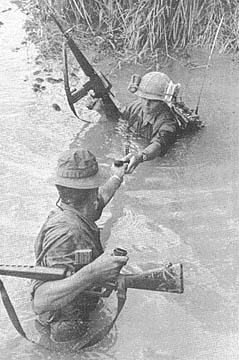 |
“IT’S YOUR WIFE” - Sergeant Arthur Brookfield of Kansas City, Mo., extends a helping hand to Specialist 4 David Shelton of Orangeville, Calif., as the men of Company C, 2d Battalion, 14th Infantry, cross a canal in search of the enemy four miles east of Cu Chi. (PHOTO BY SP4 LARRY WEIST) |
Fast Moves Crush Enemy Ambushers
Elements from the 1st Brigade, 25th Infantry Division, killed 96
North Vietnamese Army soldiers in fighting along the main supply route, High way
22, six miles northwest of Go Dau Ha. The Tropic Lightning soldiers smashed an
enemy ambush which had trapped a portion of the Cu Chi to Tay Ninh resupply
convoy.
The NVA soldiers were dug-in along the highway in an area
known as the “Little Rubber.” The enemy ambushers allowed most of the
large American convoy to pass before springing their trap, which pinned down 25
of the resupply trucks.
The fighting began just before noon as elements of Company C, 4th
Battalion (Mechanized), 23d Infantry, and Military Police gun jeeps escorting
the convoy held off the attackers.
(Continued on Back Page)
Division FSB Halts Assault, Kills 102 NVA
3D BDE - A North Vietnamese Army force tested the strength of Fire
Support Base Schofield near Dau Tieng and found the 25th Infantry Division
defenses impenetrable as 102 of the attackers were killed.
The enemy force was greeted by firepower from a combined force of
the 2d Battalion, 27th Infantry Wolfhounds and elements of the 3d Squadron, 4th
Cavalry. The infantrymen were supported by close-in artillery fire from
the 7th Battalion, 11th Artillery and the 1st Battalion, 8th Artillery.
An ambush patrol from the Wolfhound battalion had set up about 800
meters in front of the friendly lines earlier that night. When the
exchange of fire began at 12:20 a.m., the patrol was caught in the middle.
Seeing that several of his fellow soldiers were wounded by the
enemy fire and needed medical attention, Specialist 5 Lester Walker Brown, a
medic, crawled to the friendly lines to get help.
As a result of the two-hour battle, 62 enemy dead were found around
the perimeter the next morning. Three days later, an additional 40 bodies
were found. They were also believed to have been killed in the attack.
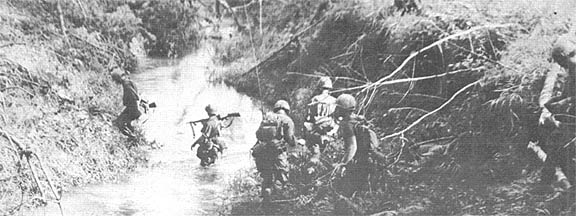 |
| HUNTING CHARLIE - Men of the 1st Battalion (Mechanized), 5th Infantry, cross a stream while searching for Viet Cong in the Michelin rubber plantation five miles northeast of Dau Tieng. (PHOTO BY SP4 DON MOUSSEAU) |
Page 2 TROPIC LIGHTNING NEWS September 16, 1968
Decorated
| SILVER STAR | |
|
LTC W. G. Skelton Jr., HHC, 2d Bn, 27th Inf CPT Carl L. Humphreys, Co D, 1st Bn, 27th Inf CPT Richard B. Cole, Co A, 1st Bn, 27th Inf CPT William J. Monahan, Co D, 3d Bn, 22d Inf CPT Richard P. Timmermeyer, D Trp, 3d Sqdn, 4th Cav CPT Theodore T. Jagosz, Co B, 1st Bn, 5th Inf CPT John J. Theologos, Co C, 1st Bn, 5th Inf CPT Gerald J. White, Co D, 3d Bn, 22d Inf 1LT William D. Mc Monagle, Co A, 4th Bn, 23d Inf 1LT Henry C. Engelke, HHC, 1st Bn, Sth Inf 1LT Richard J. Prairie, Co B, 3d Bn, 22d Inf 1LT Darrell R. Jobman, Co B, 4th Bn, 9th Inf 1LT Frank F. Calvin, HHC, 1st Bn, 27th Inf 1LT Michael R. Hatalovsky, Mob Adv Tm D 1LT William G. Barsanti, Co B, 2d Bn, 34th Armor WO1 Henry L. Hansen, Co A, 25th Avn Bn 2LT Stanton E. Thomas, A Btry, 7th Bn, 11th Arty SFC Frank J. Hettiger, Co C, 4th Bn, 9th Inf SSG Robert Fenton, Co A, 2d Bn, 22d Inf |
SSG Russell A. Babcock, Co D, 4th Bn, 9th Inf SSG Arthur Minjarez, Co C, 4th Bn, 9th Inf SSG Robert L. Nelson, Co D, 3d Bn, 22d Inf SSG Albert L. Smith, Mobile Advisory Team D SP5 Carl L. Felgenhauer, Co C, 3d Bn, 22d Inf SGT Tommy E. Cooke, Co C, 2d Bn, 22d Inf SP5 Gene A. Gray, HHC, 2d Bn, 34th Armor SP4 Gregory A. Motes, Co C, 1st Bn, 27th Inf SP4 David C. Stateler, Co A, 4th Bn, 9th Inf SP4 Gary L. Skibicki, Co A, 4th Bn, 9th Inf SP4 Felix L. Mc Carty, Co A, 2d Bn, 27th Inf SP4 Rufus F. Marshall Jr., Co D, 1st Bn, 27th Inf SP4 Mack Skeens, Co A, 4th Bn, 9th Inf SP4 Fred C. Messer, B Trp, 3d Sqdn, 4th Cav SP4 George W. Long, Co B, 2d Bn, 34th Armor SP4 Charles R. Mc Cornish, Co C, 4th Bn, 9th Inf PFC Lawrence J. Ziegler, Co A, 4th Bn, 9th Inf PFC Ignacio Mata, HHC, 1st Bn, 27th Inf |
|
DISTINGUISHED FLYING CROSS |
|
|
MAJ Carrell M. Barrow, Jr., Co A, 25th Avn Bn MAJ Richard E. Bauchspies, HHD, 25th Avn Bn CPT William Blair, D Trp, 3d Sqdn, 4th Cav CPT John W. Whitehead Jr., D Trp, 3d Sqdn, 4th Cav WO1 Stephen R. Patterson, D Trp, 3d Sqdn, 4th Cav WO1 Lawrence M. Jantz, Co A, 25th Avn Bn WO1 David L. Stock, Co B, 25th Avn Bn WO1 Henry L. Hansen, Co A, 25th Avn Bn WO1 Ralph N. Little, Co A, 25th Avn Bn WO1 Marcis Terrauds, Co A, 25th Avn Bn |
WO2 Jeffery Halliday, D Trp, 3d Sqdn, 4th Cav WO2 Edward H. Gore, Jr., Co B, 25th Avn Bn WO2 George Grinnell, Co B, 25th Avn Bn WO2 George Harrison, Co B, 25th Avn Bn WO2 Michael D. Siegel, D Trp, 3d Sqdn, 4th Cav SP5 Richard D. Kooyman, D Trp, 3d Sqdn, 4th Cav SGT Michael L. Rice, D Trp, 3d Sqdn, 4th Cav SP5 Richard A. Honyoust, D Trp, 3d Sqdn, 4th Cav SP5 Miguel Navarro, D Trp, 3d Sqdn, 4th Cav |
|
BRONZE STAR (HEROISM) |
|
|
CPT Arthur E. Blackwood, Co C, 2d Bn, 27th Inf 1LT Michael S. Rott, Co A, 3d Bn, 22d Inf 1LT James W. Thomas, Co D, 4th Bn, 9th Inf 1LT George W. Vessell, HHC, 4th Bn, 23d Inf 1LT Wayne L. France, Co A, 3d Bn, 22d Inf CSM Walter L. Moser, HHB, 25th Inf Div Arty PSG Bob H. Smith, Co B, 2d Bn, 12th Inf SP5 Franklin P. Branham, HHC, 4th Bn, 23d Inf SGT Ken Robertson, HHC, 4th Bn, 23d Inf SGT William J. Webb, A Trp, 3d Sgdn, 4th Cav SGT Paul W. Hopper, HHC, 4th Bn, 23d Inf SP5 Richard D. Munson, HHC, 4th Bn, 23d Inf |
SGT Richard J. Leboeuf, HHC, 2d Bn, 14th Inf SP4 Daniel P. Janiak, Co B, 2d Bn, 22d Inf SP4 Geroy Mingo, Co C, 3d Bn, 22d Inf . SP4 James E. Boggess, HHC, 3d Bn, 22d Inf SP4 Arthur T. McNally, HHC, 4th Bn, 23d Inf SP4 Roy C. Vaughn, HHC, 4th Bn, 23d Inf PFC Lougee W. Knox, Co A, 2d Bn, 22d Inf PFC David G. McMillian, Co A, 2d Bn, 22d Inf PFC Stephen R. Davis, Co D, 4th Bn, 9th Inf PFC James R. Bird, Co A, 2d Bn, 34th Armor PFC Everett E. Mills, HHC, 4th Bn, 23d Inf PFC Barry McFarland, D Trp, 3d Sqdn, 4th Cav |
AER Program May Help You In A Jam . . . Check It Out
Have you contributed to your unit’s AER fund drive? Or did
it just slip your mind. Do you know what the AER can mean to you?
Army Emergency Relief is to the soldier what the Huey Cobra is to
the infantryman. It is security and protection. If a man is in the
active Army or retired and needs financial assistance due to an emergency, he
may qualify.
What is considered an emergency? Non-receipt of pay,
allotment or allowance, loss of pay or other personal funds, emergency Medicare, dental or
hospital expenses are examples. Also funeral expenses for dependents,
travel expenses due to leaves of an emergency nature and emergency
transportation of dependents for port calls, payment of initial rent or to
prevent eviction as well as privation of dependents are considered emergencies.
The unit AER officer can loan you up to $250.00. When an AER
loan is made, a class E allotment is initiated. After the allotment is
made, your troubles are over.
There is no interest charge; you pay back exactly what you
borrowed.
When an emergency comes, think of AER. It is the soldier’s
key to assistance. Your contribution this month might be a small part of a
loan you might receive in the future. Contributions are voluntary and are
not demanded.
Keep Abreast – Vote
Americans are currently engaged in that quadrennial phenomenon
unique in the annals of politicial history and practice - our national
elections.
This is not to say that other countries don’t have national
elections or that they are either more - or less - effective that those in the
United States.
It is to say that our elections and the processes leading up to
them are, to say the least, different.
Starting with the first Presidential Primary early in the election
year, our populace is hallooed, hammered and harangued with the pleas, promises
and protestations of potential presidents.
The show really gets on the road with the major party conventions.
These are a combination of a Ziegfeld Revue, the World Series, a TV spectacular,
the Constitutional Convention and a Fourth of July picnic all rolled into one.
From these emerge the final candidates, selected on the basis of
popular support by the majority of individuals in that particular political
party.
Then until election day, the American people have the chance to
concentrate on the opinions, views and policies of the major candidates.
By way of newspapers, radio and television, we are able to study,
dissect, question, sift and determine the candidates’ views on everything from
aardvarks to zymurgy. From the mass of information, claims and
counter-claims, we are able to arrive at a decision as to which man, in our own
opinion, would be best suited to guide this nation in the coming four years.
The final choice is made on election day when we exercise our right as a citizen
to vote.
There may be better ways to choose the President of the United
States - no system is perfect. Although at times, our presidential
campaign seems to lack the dignity and solemnity of the high office to which the
candidates aspire, the campaign process is the free expression of free people
exercising their right to have a voice in their future.
Although the campaign may have its entertaining aspects, it’s a
serious business. Use the coming weeks wisely so you can make an
intelligent choice on election day.
Our system may not be perfect, but it is certainly the best history
has produced. Choice, even under a possibly imperfect system, is far
better than no choice at all. (AFPS)
Daily Dozen Is Thing Of Past At Polk
Privates in a basic combat training company at Fort Polk, La.,
don’t do push ups.
They are not missing out on P.T. because instead of the normal Army
exercises such as push-ups, sit-ups and deep-nee bends, the trainees are using
modern exercises designed to keep astronauts physically fit.
The exercises are performed with the aid of a 6 inch by 21 inch
device with accompanying hand hold lines and trail lines similar to wall-mounted
springs used by wrestlers and boxers. The device operates on the principle
of resistance caused by the friction of a braided rope being drawn around a
shaft - similar to a half-hitch.
It can be adjusted from negligible resistance to a pull greater
than the strength of a normal man and can be mounted indoors or outdoors, or,
for some exercises, held with the feet.
Most exercises begin with a 10 second isometric hold and conclude
with a 12-second isotonic movement. There are 12 exercises. The
isometric phase places muscle pressure against a pre-set moveable weight.
The combination of these two exercising principles develops strength, endurance
and body flexibility at the same time.
Training officers say trainees have been enthusiastic about the new
training program. The officers feel that not only is the time for physical
conditioning reduced, but the exercises have a distinct psychological,
advantage.
Letter To Finance
The letters from finance reproduced on this page were written to
finance officers during World War II and later. They were meant to be
serious-ed
Dear Sir,
“My wife received a letter stating that I have been separated
from the Army. Now as much as I would like to be a civilian again, it is
painful to report that I am still in the army.
“So I hope that you will act with the speed of an antelope and
send my wife her check. As the landlord and the wolf are fighting outside
our door to see who will get in first.”
The TROPIC LIGHTNING NEWS is an authorized publication of the 25th
Infantry Division. It is published weekly for all division units in the Republic of
Vietnam by the Information Office, 25th Infantry Division, APO San Francisco
96225. Army News Features, Army Photo Features, Armed Forces Press Service and Armed
Forces News Bureau material are used. Views and opinions expressed are not necessarily
those of the Department of the Army. Printed in Tokyo, Japan, by Pacific Stars and
Stripes.
MG Ellis W. Williamson . . . . Commanding General
MAJ Andrew J. Sullivan . . . Information Officer
2LT Don A. Eriksson . . . . . . Officer-in-Charge
SP4 Bill Berger . . . . . . . . . . . Editor
Page 3 TROPIC LIGHTNING NEWS September 16, 1968
Pilots Brave Bullets To Bring In Ammo
CU CHI - A 25th Aviation Battalion helicopter crew braved heavy
enemy fire to resupply an Army of the Republic of Vietnam (ARVN) compound under
attack from the Viet Cong.
Responding to the call for more ammunition was a Company A, 25th
Aviation Battalion Huey, commanded by Warrant Officer Pat Lawlor of Plattsburg,
Mo., and piloted by Major Jerry “Doe” Holliday of Memphis, Tenn.
It was after midnight when Lawlor and Holliday had the needed
ammunition loaded into their Little Bear helicopter at Trang Bang. They
then took off in a heavy rain storm and proceeded north to the compound near X
Rung Cay.
Lawlor and Holliday orbited their craft at 2,000 feet over the
compound for a time, hoping the barrage of RPG’s, mortars and small arms fire
would subside.
However, with the ARVN’s need for more ammunition now desperate,
Lawlor and Holliday could wait no longer. Down into the volley of fire
they took their craft, guiding in on a small light near the middle of the
compound.
The doorgunner, Specialist 4 Carlos Pizza of Astoria, N.Y., and
crew chief Specialist 4 Ronald Robinson of Midland, Tex., gripped the triggers
of their M-60 machine guns and tried to distinguish the enemy and friendly fire.
The helicopter landed safely near some concertina wire and the
ammunition was quickly unloaded. In less than 40 seconds the Huey headed
back into the sky, luckily taking only a few hits from small arms fire.
With their mission accomplished, Lawlor and Holliday took their
craft back to Cu Chi as gunships flew in to support the ARVN’s.
‘You Will Win’
Kids Show Appreciation
The Tropic Lightning Division has received over 60 letters from
school children in Canfield, Ohio, expressing their appreciation for our
presence in Vietnam. Most of them come from children in the 4th to 6th
grades in elementary school.
To read them is to feel a deep pride in America’s young and to
smile at the innocent questions and tales of summer plans and to appreciate
their sincerity of interest.
Three of the letters are contest winners in a writing competition
for elementary, junior and senior high school students. The rest come from
young people wishing to share their small world with us.
One fifth-grade boy asks, “I would like to know what it is like
in the service. Do you have a choice of what to be? Which do you
think is better, the Army, Navy, Marines or Air Force?”
Another fifth grader, who hopes to be a U.S. Marine says, “Thanks
for fighting for me so I don’t have to be under communist rule. It must
be terrible over there. I’m glad I’m not over there but if Uncle Sam
called me today, I’d go.”
Then, from an eleven year-old girl, “Going to Vietnam, you must
be very brave. I hope the war will soon be over and everyone can go
home.” Or, from another girl, “We are very proud that you men are over
there fighting for our country. Everyone knows that so many of you get
hurt or killed trying to save the lives of other people ... I sure wish I could
help.”
The letters tell of school, local events, home life, pets and some
are specifically sent to “cheer you up.” “I used to have a worm
named Mr. Munchen until my friends and myself performed open heart surgery, but
we couldn’t find his heart and we couldn’t sew him up because the needle
broke. So we fed him to my snake.”
One letter from a junior high school girl sums them all up with,
“You might have been drafted but you didn’t back out or burn your draft
card.
“They wouldn’t know what to do without you, so fight for your
country and for your life and freedom. You will win.”
 |
QUICK KILL - Wearing safety glasses to protect his eyes from ricochets, Sergeant Richard Pahlas of Rockford, Ill., fires at a pop-up target with a BB gun during training at the Replacement Training School. The BB gun is used to teach the “quick kill” technique of fast reflex firing. [see also The Birth of Quick Kill] |
Replacement Training Prepares New Men For Duty
Story And Photos
By SP4 Don Brown
CU CHI - A soldier walking down a trail is suddenly confronted by a
Viet Cong in the dense underbrush.
On another trail a point man for a patrol encounters a log blocking
the trail. Passing over it, his foot accidentally kicks the log and a
booby trap goes off.
Luckily, in both instances neither the VC nor the booby trap were
real, but only training aids used by the Replacement Training School to give new
arrivals to the 25th Infantry Division an insight into what lies ahead.
Originally known as the Ambush Academy, the school was instituted
shortly after the Division arrived in Vietnam to train selected individuals in
ambush patrolling.
According to First Lieutenant David May, of Gainsville, Fla.,
commandant of the school, the instruction varies in length depending on a
man’s assignment. A three-day course is given to all men assigned to
combat units. In addition, officers and NCO’s who will be assigned to
combat units attend a sixth day.
Courses taught during the training include: land navigation;
patrolling; assembly and care of the M-16 rifle, M-60 machine gun, and .50
caliber machine gun; artillery adjustment; target detection; and the Viet
Cong’s weapons and equipment.
The Replacement Training School is constantly adding new classes to
the curriculum. Just recently the school added a “quick kill” range
where students using BB guns learn to fire by reflex action at targets which pop
up unexpectedly.
Another addition to the training schedule is the target detection
range. Students are placed in a bunker while instructors fire different
weapons over their heads. The students are then asked to identify the type
of weapon and pinpoint its location.
At the mines and booby traps center operated by the 65th Engineer
Battalion, students are given a four-hour block of instruction on explosive and
non-explosive booby traps used by the Viet Cong.
According to Specialist 6 Blair Coleman of Harrisburg, Pa., all
instruction is oriented towards one point: “If you didn’t see your buddy
drop it, or if you didn’t drop it, don’t pick anything up off the trail - it
could be booby trapped!”
To get his point across, Blair asks a soldier to hand him a weapon
from a display. When the soldier picks up the rifle a loud but harmless
firing device explodes.
“Many of the students attending the school,” stated May, “are
suffering from what we call ‘jet lag.’ They’ve been on leave, then
climbed on a jet, and within 24 hours they are in a combat zone. The
transition hasn’t caught up with them yet. What we try to stress in our
school is that you have, at the most, six more days before going into combat.
Ask questions here; once your on the line, it could be too late.”
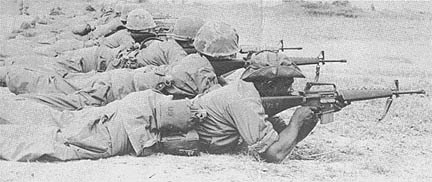 |
| COMMENCE FIRING - Students undergoing replacement training complete a six-hour block of instruction on the M-16 rifle by zeroing the weapon at the school’s rifle range. |
Page 4-5 TROPIC LIGHTNING NEWS September 16, 1968
WOLFHOUNDS Take To The High Seas - Almost
|
Story And Photos By |
 |
AIR MATTRESS FERRY - Wolfhounds of Company B, 1st Battalion, 27th Infantry, use an air mattress to ferry their equipment across a canal seven miles north of Hoc Mon. |
| OCCUPATIONAL HAZARD - Getting wet just seems to go with being an infantryman as these wading Wolfhounds will agree. |
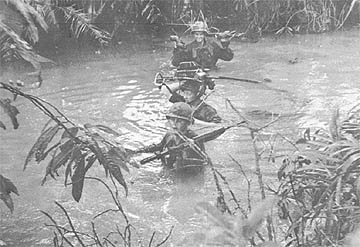 |
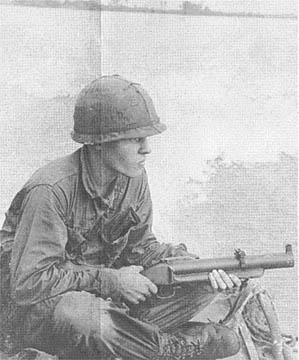 |
NO PLEASURE CRUISE - Specialist 4 Kenneth D. Weber, a grenadier for B Company, keeps a close watch for VC in the woodline along the Saigon River. Weber is a 21-year-old trooper from Cozad, Neb. |
| RIVER RIDE - Wolfhound soldiers from Company B, 1st Battalion, travel down the Saigon River during an operation near the capital city. |
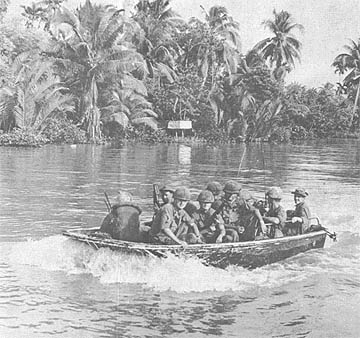 |
|
||
| SHORT!!! - Being the shortest member of a platoon can sometimes cause problems especially when crossing a canal. First Lieutenant Leonard E. Denny, 22, of White Horse, N.J., is a platoon leader with the 1st Wolfhounds. The 5 ft. 4 in. lieutenant maintains the policy that if he can cross a canal without the aid of a rope, then the entire Wolfhound platoon can. |
Page 6 TROPIC LIGHTNING NEWS September 16, 1968
VC Hit Rawlins Again; Tomahawks Still On Top
1ST BDE - The Viet Cong tried for the second
time in five days to overrun Fire Support Base Rawlins, but a staunch defense by
25th Division infantrymen turned the ground attack into another friendly
victory. Twenty-five of the attackers were killed.
Just after midnight, Company B, 4th Battalion (Mechanized), 23d
Infantry, observed 15 to 20 VC running into the woodline adjoining the fire
support base 3 miles east of Tay Ninh. First Lieutenant David D.
Blanchard, company commander from Trenton, N.J., immediately directed short-fuzed
artillery rounds from the howitzers of Charlie Battery, 7th Battalion, 11th
Artillery on the lurking figures.
Shortly thereafter, the VC simultaneously launched a mortar and
rocket and ground attack. The men of Fire Support Base Rawlins were more
than ready. Lieutenant Colonel Clifford C. Neilson of Mobile, Ala., had
ordered his men to put out concertina wire four strands deep and four strands
high. Command-detonated claymore mines were also placed indiscriminately
around the perimeter.
“When the first mortar round dropped in,” recalled Specialist 4
James Faddis of Denver, Colo., “we knew what was coming next. Everyone ran
for the bunkers, but we were really ready for them.” Huge wire screens
had been placed in front of every armored personnel carrier, and the enemy.
RPG’s harmlessly exploded in the screens causing no damage to the APC’s.
Major Cain A. Bridgman of Chattanooga, Tenn., the Tomahawk
operations officer called in helicopter gunships, and they poured their rockets and
tracers on the enemy who had regrouped for another attack The VC had a
couple of tricks of their own. They placed two twin .51 caliber machine
guns on the north and south sectors of the perimeter. As the gunships
ripped the ground beneath them, the enemy gun teams opened up with both guns
establishing interlocking fire. Bridgman, realizing the danger that the
anti-aircraft fire could cause the gunships, requested air strikes. Their
first few passes were over the enemy gun teams and the anti-aircraft positions
were silenced permanently.
The sweep outside the perimeter the next morning turned up 25 enemy
bodies and two suspects. In addition, 5 AK-47 rifles, 3 AK-50 light
machine guns, 22 rounds of 60mm mortar, 5 RPG-2 rocket launchers, 47 RPG rounds,
32 RPG boosters, 7 bangalore torpedoes, 71 grenades, and 3,500 rounds of small
arms ammunition were found.
 |
| PROTECTION FROM RPG’S - Private First Class Dennis Hedim of Long Prairie, Minn., examines a cyclone fence which took 12 direct hits from enemy RPG’s during the second battle at the 25th Infantry Division’s Fire Support Base Rawlins III, three miles east of Tay Ninh. Fences of this nature are placed around APCs to pre-detonate RPG rounds. The defensive fence proved its worth as it protected the men of Bravo Company, 4th Battalion, (Mechanized), 23d Infantry, and their tracks during the fierce night battle which accounted for 25 enemy dead. (PHOTO BY CPT LES RASCHKO) |
DSC For Heroism In War Zone C
Awarded To Manchu Platoon
Leader
CU CHI - A 25th Infantry Division platoon leader has received the
Distinguished Service Cross, the nation’s second highest award for heroism,
for his actions during a helicopter extraction operation in War Zone C.
The award was presented to First Lieutenant Hector E. Colon from
Chicago, Ill., by Secretary of the Army Stanley R. Resor during ceremonies at Cu
Chi.
 Lieutenant Colon had just completed a reconnaissance-in-force
mission with his platoon from Company B, 4th Battalion, 9th Infantry, and was
awaiting extraction when his men came under heavy rocket, mortar, automatic
weapons and small arms fire from an estimated 400 Viet Cong.
Lieutenant Colon had just completed a reconnaissance-in-force
mission with his platoon from Company B, 4th Battalion, 9th Infantry, and was
awaiting extraction when his men came under heavy rocket, mortar, automatic
weapons and small arms fire from an estimated 400 Viet Cong.
Colon quickly positioned his men to repel the advancing enemy.
During the initial attack, his radio operator was wounded and the radio damaged.
Colon secured another set to direct artillery fire and air strikes on the Viet
Cong, sometimes to within five meters of his position.
Colon killed five enemy soldiers who tried to overrun the
platoon’s perimeter. As the firing subsided, he supervised the
evacuation of casualties, made sure the rest of his men were extracted, and
insured all weapons and equipment were recovered.
His leadership was directly responsible for routing the numerically
superior Viet Cong.
FOR EXTRAORDINARY HEROISM - (Above, right) Secretary of the Army Stanley
R. Resor presents the Distinguished Service Cross to First Lieutenant Hector E.
Colon during ceremonies at Cu Chi. Colon’s leadership was directly
responsible for routing an estimated 400 Viet Cong in War Zone C.
Mech Makes First Helicopter Assaults
3D BDE - Abandoning its armored personnel carriers for the first
time since its reorganization as a mechanized battalion, the 2d Battalion
(Mechanized) 22d Infantry made its first helicopter assault.
Charlie Company of the 3d Brigade unit, commanded by First
Lieutenant Gordon F. Kelley of Jonesport, Me. was picked up by the helicopters
just outside its positions near Tan Son Nhut air base. They air-lifted
into marshes along the Hoc Mon Canal, while the battalion commander, Lieutenant
Colonel King J. Coffman of La Crescenta, Calif. directed the assault from
overhead.
After the sweep, which failed to find the enemy, they were again
picked up and returned to their positions. Lieutenant Colonel Coffman said
he was pleased with the operation. He complimented Kelley for the
professionalism that his soldiers displayed on their first air assault, and said
that “Charlie Company certainly set the pace for the battalion today.
Hostile Fire Draws Ship, Finds Cache
1ST BDE - A large ammunitions cache was found by an element of the
Golden Dragons after a Viet Cong inadvertently led them to its location by
attracting helicopter gunships.
As Company B, 2d Battalion, 14th Infantry began their sweep
to a woodline, the escorting helicopter gunships reported receiving enemy fire.
When the pilot of the Stinger gunships of the 116th Combat Assault Helicopter
Company radioed battalion commander, Lieutenant Colonel Thomas Nunn, of the
incoming fire, Nunn directed the Dragons to do an about face and search the area
believed to be the source of the enemy fire.
After the initial find was made, and it was apparent more enemy
supplies were in the immediate area, shovels were flown in and the extraction of
enemy supplies began. Nearly 30,000 rounds of 7.62mm ammunition; 107 RPG-2
rounds; 170, 82mm mortar rounds; 300 feet of bangalore torpedoes; and 49,
25-pound anti-tank mines were found.
Before leaving the area, the Golden Dragons destroyed 25 enemy
fortifications.
Page 7 TROPIC LIGHTNING NEWS September 16, 1968
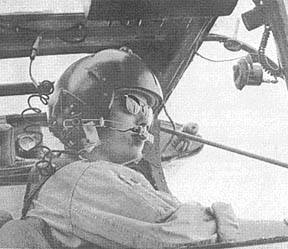 |
CHECK - Air Force Captain Walter Lehman, forward air controller with the 25th Infantry Division’s 1st Brigade makes pre-flight checks before take-off. Lehman from Phoenix, Ariz., guides Air Force jets which bomb enemy troops and supply areas in Tay Ninh Province. |
FAC’s - Air Force Eyes – Bring Smoke On Viet Cong
Story And Photos By CAPT Les Raschko
1ST BDE - An Air Force pilot, alone in the skies over Vietnam, is
giving the Army’s infantrymen an upper hand in their fight as he brings down
the devastation of air power on enemy troops.
These lone eagle pilots, in their small, lightweight Bird Dog
aircraft, are U.S. Air Force Forward Air Controllers (FAC). The FAC’s
are grouped into an organization called the Tactical Air Control Party (TACP)
and are co-located with Army units at division and brigade levels throughout
Vietnam.
The FAC’s are responsible for planning and coordinating air
strikes for Army ground troops as they fight the enemy in his backyard of
jungles and rice paddies.
The TACP attached to the 1st Brigade is a relatively small unit
with a big job. There are five officer-pilots, five radiomen, and two
maintenance men. The senior air liaison officer for the TACP attached to
the 1st Brigade is Air Force Major Robert L. McKaig of Ithaca, N.Y.
“TACP lives and works with the brigade and its units. We
advise the Army commanders on how to use direct air support, whether close or
pre-planned missions,” stated McKaig.
The FAC’s fly the O-1 Bird Dog, a small single engine plane that
enables them to remain aloft for long periods of time. Each pilot will fly
four to six hours per day, accumulating no more than 125 hours per month.
The FAC primarily observes and directs each air strike in the 1st Brigade’s
area of operation. Each FAC is fighter qualified, so he fully realizes the
problems encountered by fighter pilots traveling 400 MPH dropping their ordnance
on a target.
The FAC also assesses damage to targets, gathers weather data and
reports intelligence information back through Army channels. Called the
visual reconnaissance program (VR), it is very essential to the TACP’s overall mission.
“It is not as rewarding and exciting as putting in air strikes,
but VR, or finding the enemy, is a hard tedious job,” commented McKaig. “Circling a suspected target for hours and looking through field glasses to
see if you can spot movement on the jungle floor below is very arduous work,”
he said.
The VR program also pumps essential intelligence sightings to the
S-2 for planning B-52 strikes. These strikes in the 1st Brigade’s area
according to Major McKaig, “. . . have interdicted the VC. There’s no
doubt about it. B-52’s in this area have given Charlie a tough time.
Dropping high explosive bombs within 50 meters of American troops
calls for close and constant communication between the Air Force pilots and Army
infantrymen.
The Tactical Air Control Party has its radio communications center
located in the 1st Brigade’s Tactical Operations Center. With the two
service centers but a few steps away, coordination has become a regular and
natural daily exercise.
Major McKaig attends all briefings and advanced planning meetings.
He knows the planned patterns of movement of the infantry, which enables him to
better understand where he must have Air Force fighters place their ordnance.
During operations Saratoga through Toan Thang, from February 29th
to August 11th of this year, the FAC fliers of the 1st Brigade flew 1,092
missions. The Air Force pilots directed air and artillery strikes that
killed 250 enemy soldiers, destroyed 3,728 bunkers and smashed over 6,508 meters
of trench line.
| TAKE OFF - Captain Lehman heads his lightweight O-1 Bird Dog aircraft down the runway at Tay Ninh. The plane can stay in the air for hours at a time and carries marking rockets under its wings. |
 |
 |
PREPARATION - Airman First Class Johnnie Waid of Cucomonga, Calif., loads a forward air controller's O-1 Bird Dog aircraft with 2.75 inch marking rounds. Waid loads and arms the rockets which are used to pinpoint enemy targets. |
Heads Interpreters
Capt Thinh Liaison Officer
CU CHI - Captain Nguyen Van Thinh was recently assigned to the 25th
Infantry Division as the III Corps Vietnamese liaison officer.
In this capacity Thinh assists the commanding general and unit
commanders on military matters relating to operations, intelligence and support
and recommends 25th Division soldiers for Vietnamese awardis with the
concurrence of the unit commanders. In addition he is in charge of the 120
Vietnamese Army Interpreters assigned to the division.
Captain Thinh brings to his new assignment a varied military
background which includes attendance at officer career courses conducted at Ft.
Benning, Ga. After graduation from the Dalat Military Academy at Dalat,
Vietnam, Thinh was assigned to various positions of command ranging from platoon
to battalion sized units.
He served as an instructor at the U.S. Army Counterinsurgency
Course conducted on Okinawa from 1961-1962 and then returned to Vietnam to
attend the Vietnamese Command and General Staff College at Dalat.
From 1966 to 1967 Captain Thinh served as chief of the tactical
committee at the Vietnamese NCO Academy in Nha Trang; and prior to his
assignment here, he was the chief of the operations section at III Corps.
His military education includes attendance at the Company
Commanders Course and the Associate Infantry Officer Career Course both
conducted at Ft. Benning.
Thinh has been decorated with the Vietnamese Cross of Gallantry
with Palm, Cross of Gallantry with Silver Star and is a three time awardee of
the Cross of Gallantry with Gold Star.
| NEW LIAISON - Captain Nguyen Van Thinh is the new Vietnamese liaison officer from III Corps to the 25th Division. (PHOTO BY SP4 DON BROWN) |
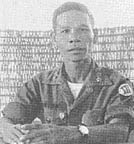 |
Tomahawk Armada Arrives
1ST BDE - While on a reconnaissance-in-force mission eight miles
southeast of Tay Ninh, waterborne infantrymen from the 4th Battalion
(Mechanized), 23d Infantry Tomahawks, uncovered a small Viet Cong base camp
almost in time to be dinner guests.
Company C, commanded by Captain Henry R. Phillips of Columbus, Ga.,
inched its way through an abandoned rubber plantation adjacent to a small
stream. With some of the armored personnel carriers “swimming” in the
stream, the going was quite slow because of the numerous potential ambush sites
at the bends in the stream.
First Lieutenant Joseph Rio, a Tomahawk platoon leader from Clute,
Tex., recalled the terrain: “The darn stuff was pretty thick, but I knew that
if anyone was going to find anything, we would.
Then the pieces started to form the complete picture.
Assorted pots and pans filled with warm rice were apparently kicked
over in the enemy’s haste to escape. Also scattered about was enough
field and web gear to equip a reinforced enemy platoon. In addition, the
1st Brigade soldiers found 17 100-pound bags of rice, a 100-pound block of salt,
four bicycles and eight gallons of motor oil.
Page 8 TROPIC LIGHTNING NEWS September 16, 1968
Wounded Pilot Makes It . . .
(Continued From Page 1)
Turning the controls over to Kane, from Fort Worth, Tex., Garrison
said a silent prayer and began speaking slowly and firmly to Tuck.
“You must not land. Tuck, listen to me. You can make
it back to Cu Chi - you can and you will - I’ll help you.”
Haltingly, Tuck’s pain-racked mind started responding to
Garrison’s encouragements and instructions. Tuck, very weak from loss of
blood, could not follow complicated flying instructions so Garrison gave him
simple directions.
“Turn left Tuck. A little more . . . that’s it, keep
going . . . OK. Now pull up Tuck. Pull up on the cyclic, you’re
too low!”
Slowly the Cayuse gained altitude and the Cobra moved into a
position directly above and behind the stricken craft. In that manner the
two helicopters flew back to Cu Chi.
At one point the blood from Tuck’s leg shorted out the radio next
to his seat and a hurried change to another set was made.
As the Cobra approached Cu Chi, Garrison called the tower and told
them he was escorting in a crippled helicopter. Crash rescue trucks raced
across the steel plates to take up standby positions near the landing strip
while the traffic controller cleared the skies to give the crippled Cayuse every
possible chance.
Tuck radioed one last message before concentrating all his
remaining strength on landing the ship, “I’m going to bring her in on a
sliding landing, wish me luck.”
The Cobra pilots, realizing that he was going to slide along the
runway on the helicopters’ skids instead of trying to drop the craft straight
down, kept their eyes glued to the Cayuse and waited. There was nothing
more they could do.
Wobbling erratically, the Cayuse plummeted towards the ground.
Several feet above the runway the helicopter flared up and swerved wildly to the
left.
Garrison held his breath, sure that the tiny ship would flip over
and disappear in a mass of flames.
At the last moment Tuck straightened the ship out and dropped it
softly to the ground. Too weak to lift his arms and twist the knobs to
shut off the engine, he grasped the handle of the emergency fuel cut-off and
yanked it up before he collapsed.
Tuck remembers nothing of those last few minutes, but Kane, leaping
out of the Cobra almost before it touched the ground was the first one to reach
the craft. Feebly, Tuck motioned him towards the observer. The
captain would not let anyone help him until Edwards was pulled out of the
Cayuse.
In a war where supersonic jets have replaced the single engine
bi-plane and “seat-of-the-pants” flying, the last outpost where courage and
skill are the deciding factors is in the helicopter war over Vietnam.
Shortly after the historic mission Captain Joseph Tuck was awarded
the Distinguished Flying Cross for gallantry.
| Captain Joseph Tuck receives the Distinguished Flying Cross from Colonel James Smith, Deputy Commander of the 1st Aviation Brigade. |
 |
Fast Moves Crush Enemy Ambush...
|
|
Thanks to
Allan Azary, 1st Bn. (Mechanized), 5th Inf. for sharing this issue,
Kirk Ramsey, 2nd Bn., 14th Inf. for creating this page.
This page last modified 8-12-2004
©2004 25th Infantry Division Association. All rights reserved.